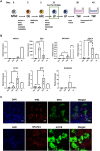Differentiation of CD166-positive hPSC-derived lung progenitors into airway epithelial cells
- PMID: 39387302
- PMCID: PMC11554259
- DOI: 10.1242/bio.061729
Differentiation of CD166-positive hPSC-derived lung progenitors into airway epithelial cells
Abstract
The generation of lung epithelial cells through the directed differentiation of human pluripotent stem cells (hPSCs) in vitro provides a platform to model both embryonic lung development and adult airway disease. Here, we describe a robust differentiation protocol that closely recapitulates human embryonic lung development. Differentiating cells progress through obligate intermediate stages, beginning with definitive endoderm formation and then patterning into anterior foregut endoderm that yields lung progenitors (LPs) with extended culture. These LPs can be purified using the cell surface marker CD166 (also known as ALCAM), and further matured into proximal airway epithelial cells including basal cells, secretory cells and multiciliated cells using either an organoid platform or culture at the air-liquid interface (ALI). We additionally demonstrate that these hPSC-derived airway epithelial cells can be used to model Influenza A infection. Collectively, our results underscore the utility of CD166 expression for the efficient enrichment of LPs from heterogenous differentiation cultures and the ability of these isolated cells to mature into more specialized, physiologically relevant proximal lung cell types.
Keywords: Air-liquid interface; CD166; Directed differentiation; Human pluripotent stem cells; Influenza; Multiciliated cells; Organoids; Proximal lung airway.
© 2024. Published by The Company of Biologists Ltd.
Conflict of interest statement
Competing interests The authors declare no competing or financial interests.
Figures



References
-
- Chen, Y. W., Huang, S. X., de Carvalho, A. L. R. T., Ho, S.-H., Islam, M. N., Volpi, S., Notarangelo, L. D., Ciancanelli, M., Casanova, J.-L., Bhattacharya, J.et al. (2017). A three-dimensional model of human lung development and disease from pluripotent stem cells. Nat. Cell Biol. 19, 542-549. 10.1038/ncb3510 - DOI - PMC - PubMed
-
- Ciancanelli, M. J., Huang, S. X., Luthra, P., Garner, H., Itan, Y., Volpi, S., Lafaille, F. G., Trouillet, C., Schmolke, M., Albrecht, R. A., et al. (2015). Infectious disease. Life-threatening influenza and impaired interferon amplification in human IRF7 deficiency. Science 348, 448-453. 10.1126/science.aaa1578 - DOI - PMC - PubMed
-
- da Paula, A. C., Ramalho, A. S., Farinha, C. M., Cheung, J., Maurisse, R., Gruenert, D. C., Ousingsawat, J., Kunzelmann, K. and Amaral, M. D. (2005). Characteriza.^ption of novel airway submucosal gland cell models for cystic fibrosis studies. Cell. Physiol. Biochem. 15, 251-262. 10.1159/000087235 - DOI - PubMed
Publication types
MeSH terms
Substances
Grants and funding
LinkOut - more resources
Full Text Sources
Research Materials
Miscellaneous

